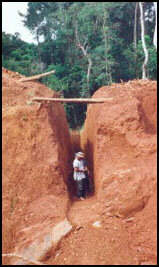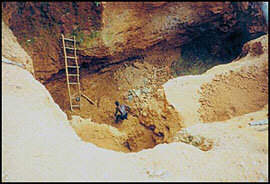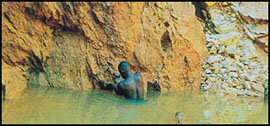 MINING MINING |
 Iron ore Iron ore |

The main basis to the wealth of Liberia lies in its natural resources, and more particularly on the underground ones. The most obvious one is iron ore. These are the words of a foreign diplomat accredited to Liberia.
This commodity unquestionably was the number one revenue earner for Liberia, bagging some 208million USD in 1988 into government coffers, representing some 47 % of the total exports. Now the mines are all closed, but the iron ore is still in abundance and of good quality too.
There are proven reserves of some 800million tons of iron ore in Liberia with content of 35-65 %, while there has been a discovery of deposits amounting to an estimated one billion tons of high-grade ore.
Deposits on the northern border with Guinea are among the richest in this part of Africa, according to studies conducted. The most interesting factor, from a commercial point of view, because iron ore is never a hundred percent pure, but the contaminants in the ore in the north are quite easy to remove, thus increasing the value of the ore.
Liberia's main iron ore deposits are in two sites: the Bong range in the Central West of the country and the Yekepa iron ore that is north of Mount Nimba.
 | Four mines operated by Swedish, American and German multi-million dollar corporations shut down intermittently due primarily to a slump in the world market prices for the commodity and partly to a civil conflict that disrupted normal activities.
Studies indicate that re-starting the old mines or operating new ones require infusion of sizable investment capital. Several countries are said to be eyeing this sector.
 Gold and diamonds Gold and diamonds |
There are at least three concessions doing gold and diamond mining particularly in the west and southeast of the country, although the two commodities are also mined in small-scale operations.

Freedom Gold, Mano River Resources Inc. and another yet prospecting company, AM-Lib are already in the mining industry.
Production estimates are a bit difficult to compute due to smuggling of the portable gem but, officially, diamond earned 84million USD in export revenue in 1988, while gold production was said to be between 40 to 45 grams per month in the mid eighties.
The government has passed a new mining and mineral law, regulating the industry and providing incentives for investors wanting to do large scale, mechanized mining of the minerals.
The disparity between licensed and unlicensed miners is high, with many of them doing illicit alluvial mining. This trade is spurred by the increasing number of diamond brokers in areas where mining is going on and the cities willing to buy the minerals. |

